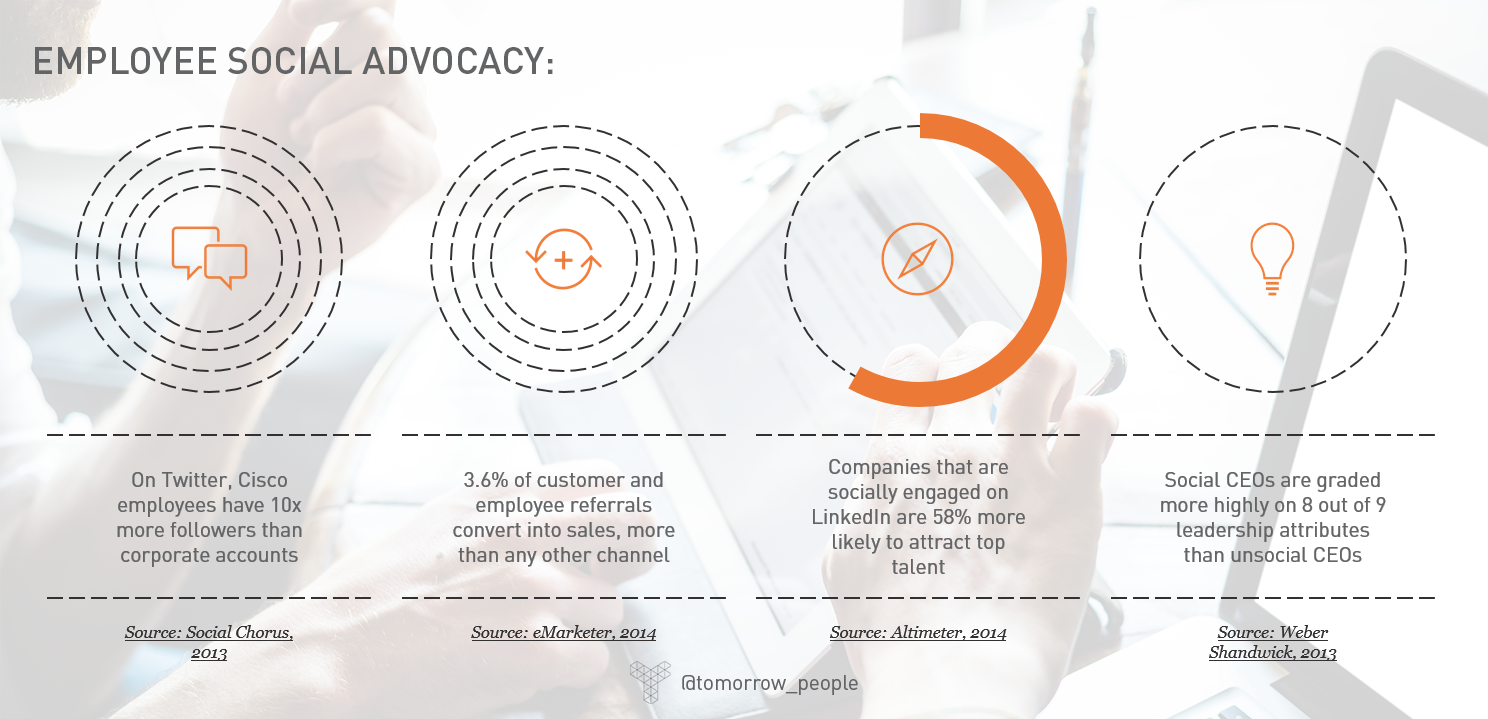
The Social Enterprise: Why Social Employee Advocacy Could Be Your Greatest Untapped Resource
In the first part of this presentation from the B2B Marketing Summit 2015 we look at how social employee advocacy could dramatically increase the reach and engagement of your marketing activity.
This is the first part of a two part post on social media and employee advocacy – read part two here
What if we told you that you were missing out on a key marketing channel that could dramatically increase your reach, awareness and engagement, all at a minimal investment compared to your other, more traditional marketing channels?
The secret, put simply, is your own employees.
What is social employee advocacy?

As marketers, we all know that people to people marketing is far more effective than business to business marketing , with recommendations from peers consistently rated the most trusted form of advertising. We also know that up to 60% of the B2B purchase journey is complete before a buyer ever speaks to your sales team, and 98% of business decision makers are actively using social media for work. All this points to the fact that social networks and peer networks are increasingly important elements of the B2B decision making process.

Over the last few years, we’ve spent a lot of time talking a lot about influencer marketing and customer advocacy, and how individuals can help promote your brand through word of mouth and social proof. Yet, we’re often ignoring a pool of influencers right under our noses – even better, these are people who are already educated on our products and services, already engaged with our brands, and who already have a vested interest in driving our performance. Your employees have the potential to be one of your most valuable marketing assets.
This potential goes beyond the marketing department, with applications across functions and wide-ranging benefits that touch multiple areas of B2B businesses, including sales, HR and the C-Suite.
Benefits of social employee advocacy
For marketing, the biggest win that employee advocacy offers is increasing reach beyond your owned social channels – as a combined force, your employees have invested far more time building their social networks and engaging with followers than you could ever hope to as a brand. An analysis of Cisco’s Twitter presence, for example, found that Cisco’s employees have 10 times more followers than corporate accounts, and with only a 2% overlap in audiences. That represents a huge pool of potential prospects who could be personally introduced to your business.

Even if only a small proportion of your employee’s connections represent your target personas, bringing them in as warm leads via a personal referral is far more efficient than hoping to reach them via other marketing channels. Studies have shown that 15% of customer and employee referrals lead to an opportunity, and that referrals convert into sales at 3.6%, much higher than other sales channels.
From a HR perspective, companies that are socially engaged on LinkedIn – that is, those that utilise LinkedIn for hiring, marketing, sales and collaboration – are 58% more likely to attract top talent. Meanwhile, there are huge benefits for employee engagement as well – existing employees tend to be more inspired, more optimistic about their company, and are more collaborative and connected with other team members.
Finally, looking to the C-Suite, CEOs who are active on social media are graded more highly on 8 out of 9 leadership attributes by their executives, more likely to be seen as good communicators, accessible and inspiring.
The current social employee advocacy landscape

Despite the clear benefits, adoption of social media by key figures at B2B companies is still low. A study by CEO.com last year revealed that although more business leaders are utilising social media than ever before, 68% of Fortune 500 CEOs still have no presence on any major social network. Even more, of the small number that do have a Twitter account, only 69% are actively posting content, despite having an average follower count of almost 90,000 each. That’s a big audience which is being left unaddressed.
This untapped potential goes beyond the CEO – 76% of B2B marketing heads surveyed in 2014 ranked the forums and communities in their sector as very important in influencing their prospects. However, only a quarter of those marketers were confident that they had ongoing, proactive relationships with them. I’m willing to bet that the employees of those companies are involved in sector forums and communities in some capacity, even if the marketing team isn’t.
All of this represents a huge opportunity to differentiate your business from the competition, by simply making the most of assets you already have through a social employee advocacy programme.
In the second part of this post, we’ll be looking at how to take advantage of this opportunity, with a five step guide to implementing social employee advocacy at your organisation – stay tuned to find out how you can start utilising your employees to drive marketing results.
This is the first part of a two part post on social media and employee advocacy – read part two here
How socially engaged are your employees? Take our employee advocacy survey to benchmark your performance.
Read the latest positioning trends and insights.
Tap into our brand and product positioning, storytelling, and creative expertise to inspire your next strategic move.
 This is the first part of a two part post on social media and employee advocacy –
This is the first part of a two part post on social media and employee advocacy – 


